As one of America’s most popular crossovers, the 2020 Honda CR-V speaks for itself.
Spacious? Yup. Affordable? Sure. Competent? You bet.
It’s so familiar that it doesn’t need many words.
Honda gave us something more to talk about this year with the 2020 Honda CR-V Hybrid. It’s the first hybrid CR-V sold in the U.S., and statistically significant because it will be a bestseller soon. Oh, say, 20 minutes from now.
We had three questions about the CR-V Hybrid: Is it better? Is it more fuel-efficient? Is it any good?
We’ll need more words to answer those questions. That’s good, considering we’re professional writers.

2020 Honda CR-V Hybrid vs. 2020 Honda CR-V
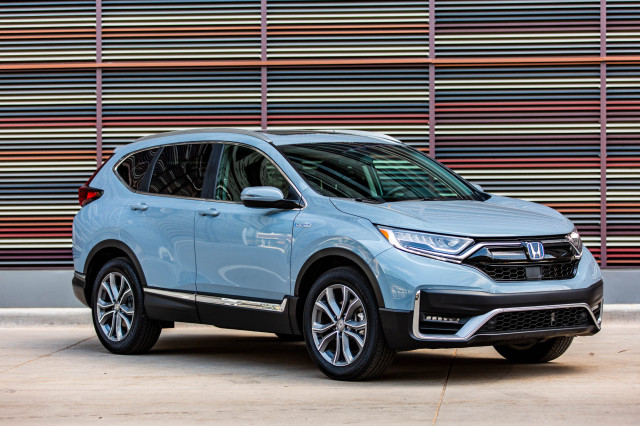
2020 Honda CR-V Hybrid
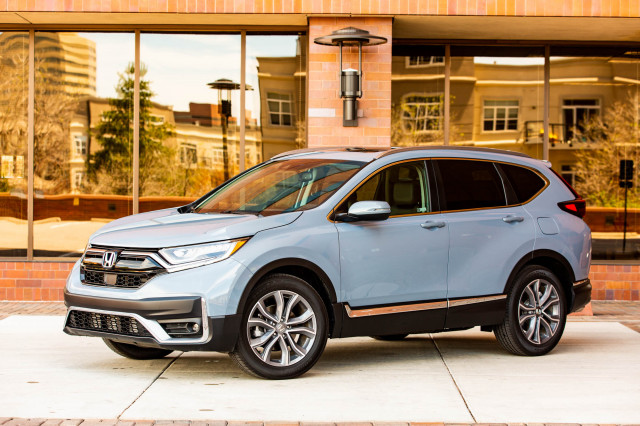
2020 Honda CR-V
CR-V vs. CR-V Hybrid: What are they?
A 1.5-liter turbo-4 powers any CR-V that doesn’t have a hybrid badge on it.
New for 2020, the CR-V Hybrid wedges a similar powertrain from the Accord Hybrid into the crossover’s stilted shoulders. The CR-V Hybrid is all-wheel drive, and uses a 2.0-liter inline-4, hybrid batteries, and electric motors in interesting ways. The engine is primarily a gas-powered generator for the hybrid batteries; electric motors typically drive the CR-V Hybrid’s wheels. That’s different than many other hybrids on the road—it shares more in common with a diesel train, actually—but it’s how Honda primarily powers its hybrids. (And important to remember when fuel economy comes up.)
The net power from the CR-V Hybrid’s confab of gas engine and electric motors is 212 horsepower, up from the CR-V’s 190 hp from the turbo-4 alone.
As you might expect, all of the above is almost entirely imperceptible from inside the CR-V, which is designed to be more user-friendly than a stuffed animal. The CR-V doles out power with less sass than elevator jazz.
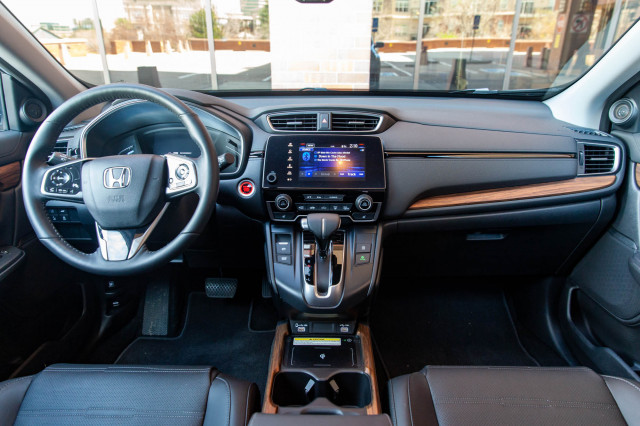
2020 Honda CR-V
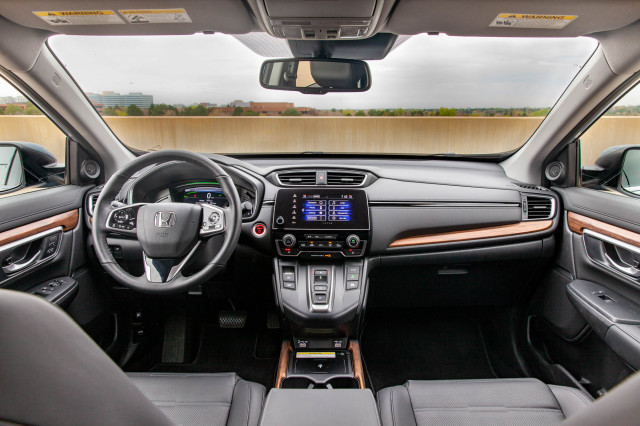
2020 Honda CR-V Hybrid
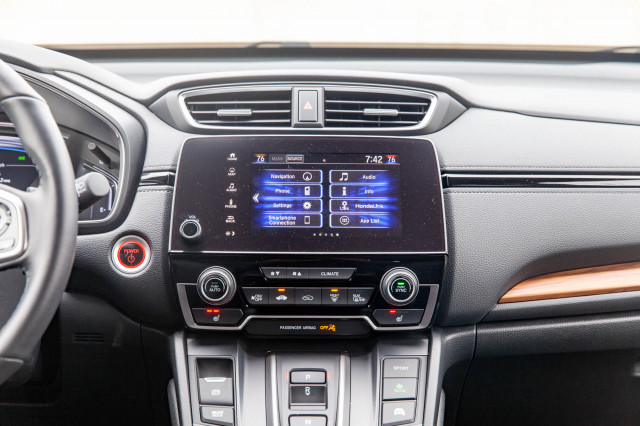
2020 Honda CR-V Hybrid
The interiors of the CR-V and CR-V Hybrid are mostly identical aside from a different shifter and a slightly smaller cargo hold (39.2 cubic feet vs. 33.2 cubic feet).
They drive identically, have the same turning circle, and are identically equipped. Our two CR-Vs even wore the same color—how embarrassing that must have been when they arrived at the gala.
The CR-V, hybrid or not, excels at being a capable and competent compact crossover. At 65 mph, for example, both crossovers were quieter than normal conversation—65 decibels to be exact.
All CR-Vs except the base models are equipped with a 7.0-inch touchscreen with Apple CarPlay and Android Auto software. And if you’ve got one of those touchscreens, you’ve got an audio system with at least six speakers, which sounds better than Honda’s base four-speaker system.
The rear seats are spacious and big enough for three adults with more than 40 inches of leg room. That man-spread-ready space is made better with comfortable seats shod in cloth or synthetic leather upholstery that feels more reliable than muni bonds.

2020 Honda CR-V
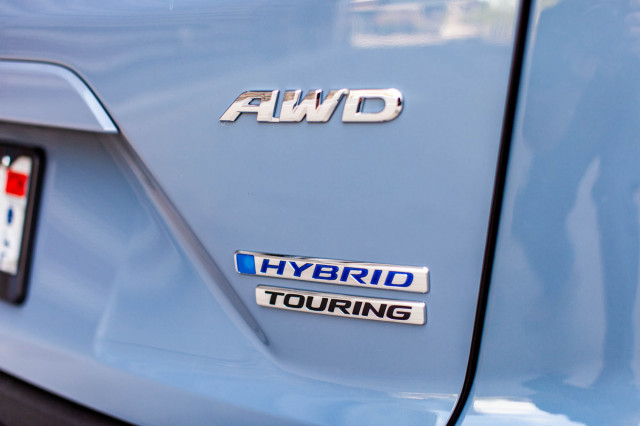
2020 Honda CR-V Hybrid

2020 Honda CR-V
CR-V vs. CR-V Hybrid: Which is more fuel-efficient?
Relatively speaking, every CR-V is fuel-efficient. The EPA rates the 2020 CR-V with all-wheel drive at 27 mpg city, 32 highway, 29 combined. The first CR-Vs in 1997 rated 19/23/21 mpg, almost the same rating as the 2020 Honda Passport today, which does it with two more cylinders, a lot more space, and a lot more weight.
Put more simply: Passenger cars have made a lot of progress already.
The EPA rates the CR-V Hybrid at 40/35/38 mpg, which isn’t a misprint: the city rating is much higher than the highway rating, primarily because of how Honda’s hybrid system works. (Remember that part earlier?)
At low speeds around town, electric motors mostly take over and propel the CR-V much more efficiently than the gas version. At higher speeds, the CR-V Hybrid can clutch in the gas engine to help drive the wheels, which is less efficient.
This all maths, too.

2020 Honda CR-V Hybrid

2020 Honda CR-V Hybrid

2020 Honda CR-V
We drove the CR-V and CR-V Hybrid on identical 53.8-mile highway loops around Denver. Same speeds, same acceleration tests, and roughly 65 mph all the way. The CR-V managed 34.4 mpg on the highway loop, the CR-V Hybrid? Just 37.1 mpg over the same loop.
If all you did was drive on the highway, the CR-V Hybrid would save you about $1 each week in fuel costs. That’s not even a coffee anymore.
In the city, on identical 35.3-mile loops, the CR-V Hybrid does much better. We managed 42.8 mpg in stop-and-go traffic and speeds 40 mph or slower. The same route in the CR-V? 28.3 mpg.
Not only was the CR-V Hybrid more fuel-efficient, but also it was much easier to drive. The stop/start system that shuts off the gas engine at stops to conserve fuel is smoother in the CR-V Hybrid; the regular CR-V can shake like a Labrador in a rainstorm.
Their differences in horsepower are largely academic, but the CR-V Hybrid accelerates quicker because electric motors have little lag in spinning up their wheels. How do we know? We drag-raced the CR-Vs of course. No really, it was great.
At the end of our testing, the CR-V and CR-V Hybrid piled on more than 150 miles in varied chores and errands, highway jogs, and city slogs. The final tally? 38.8 mpg for the hybrid, 30.1 mpg in the regular. That’s $4 per week, enough for a coffee, or $20 a month. If you drive more around town, you could save even more.
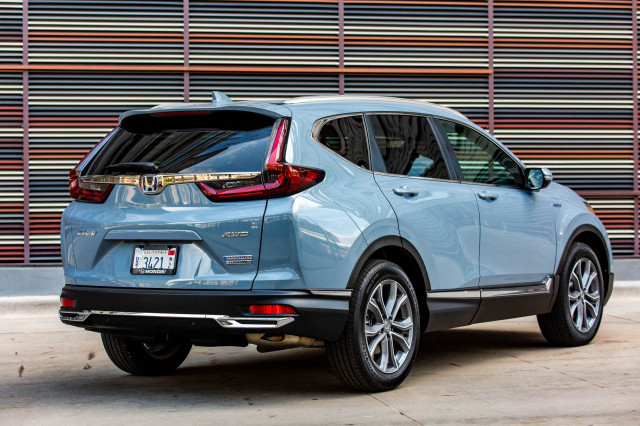
2020 Honda CR-V Hybrid
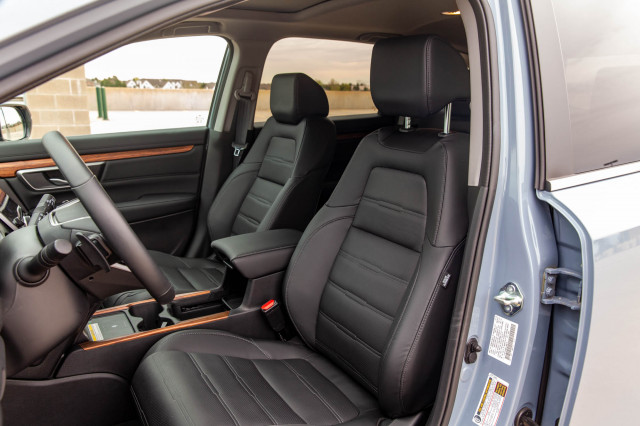
2020 Honda CR-V Hybrid
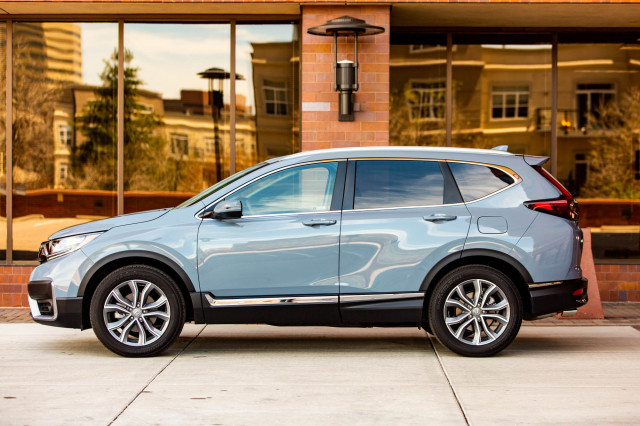
2020 Honda CR-V

2020 Honda CR-V
CR-V vs. CR-V Hybrid: Is the hybrid worth it?
The CR-V Hybrid costs $1,200 more than an identically equipped CR-V with all-wheel drive. If we use our observed fuel-economy scores, making up that difference at $2.19 per gallon gas prices will take…a while. Five years actually based on 15,000 vehicle miles driven, and 55% of those miles at city speeds. Rising gas prices can recoup that difference a little quicker, but the CR-V Hybrid is more than just the most-efficient crossover between the two. The CR-V Hybrid is also the most refined and the one we would recommend for its seamless power and quiet operation—as long as all-wheel drive is a must-have.
If it’s not, a front-drive CR-V is $3,700 less than a comparably equipped CR-V Hybrid and probably makes better fiscal sense.
Peppered into the CR-V Hybrid’s value equation is its appeal as a low-cost commuter for just about any task. That has a certain appeal beyond brute-force fuel economy figures, and it’s proven valuable for the CR-V since its introduction.
[ad_2]
Source link
